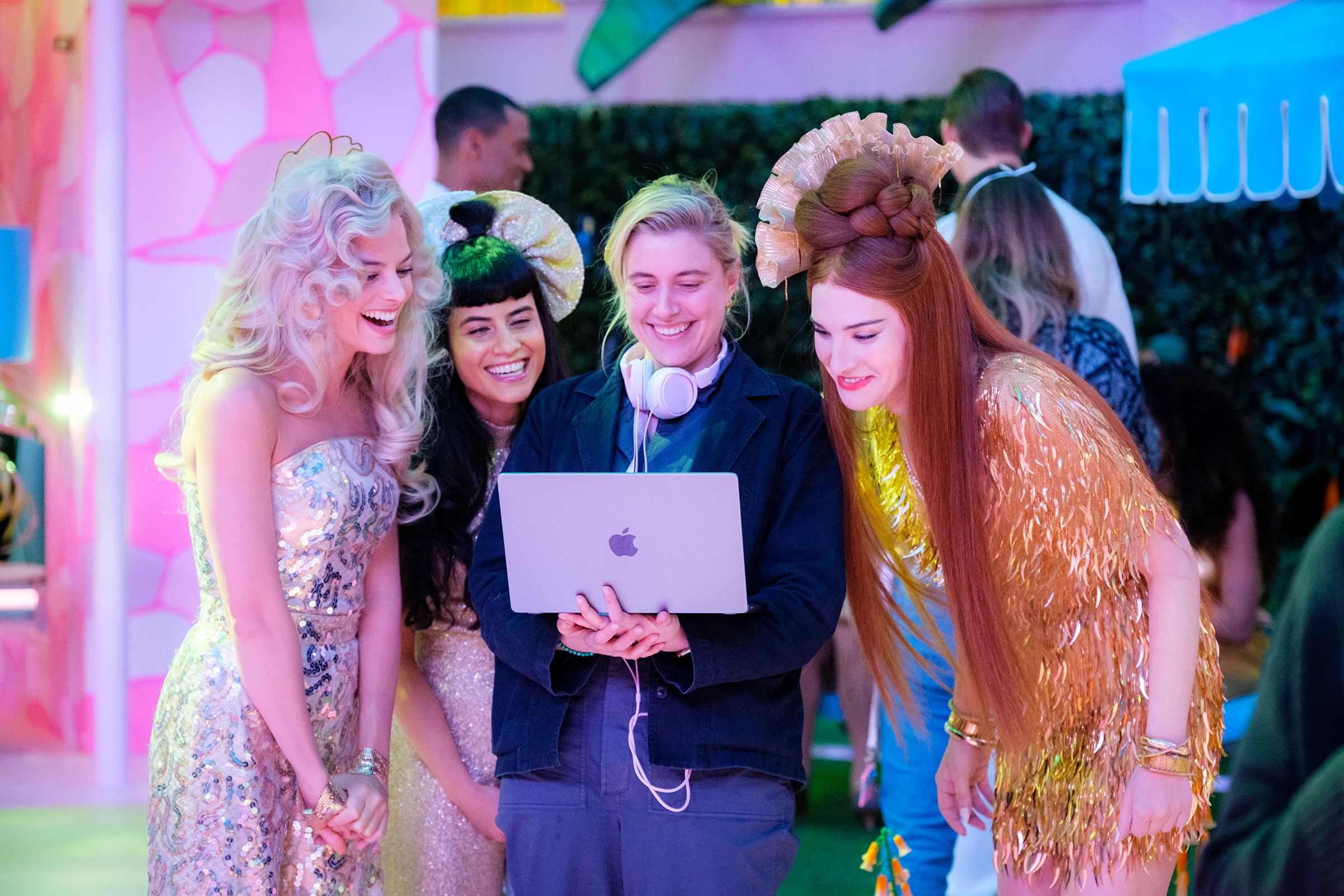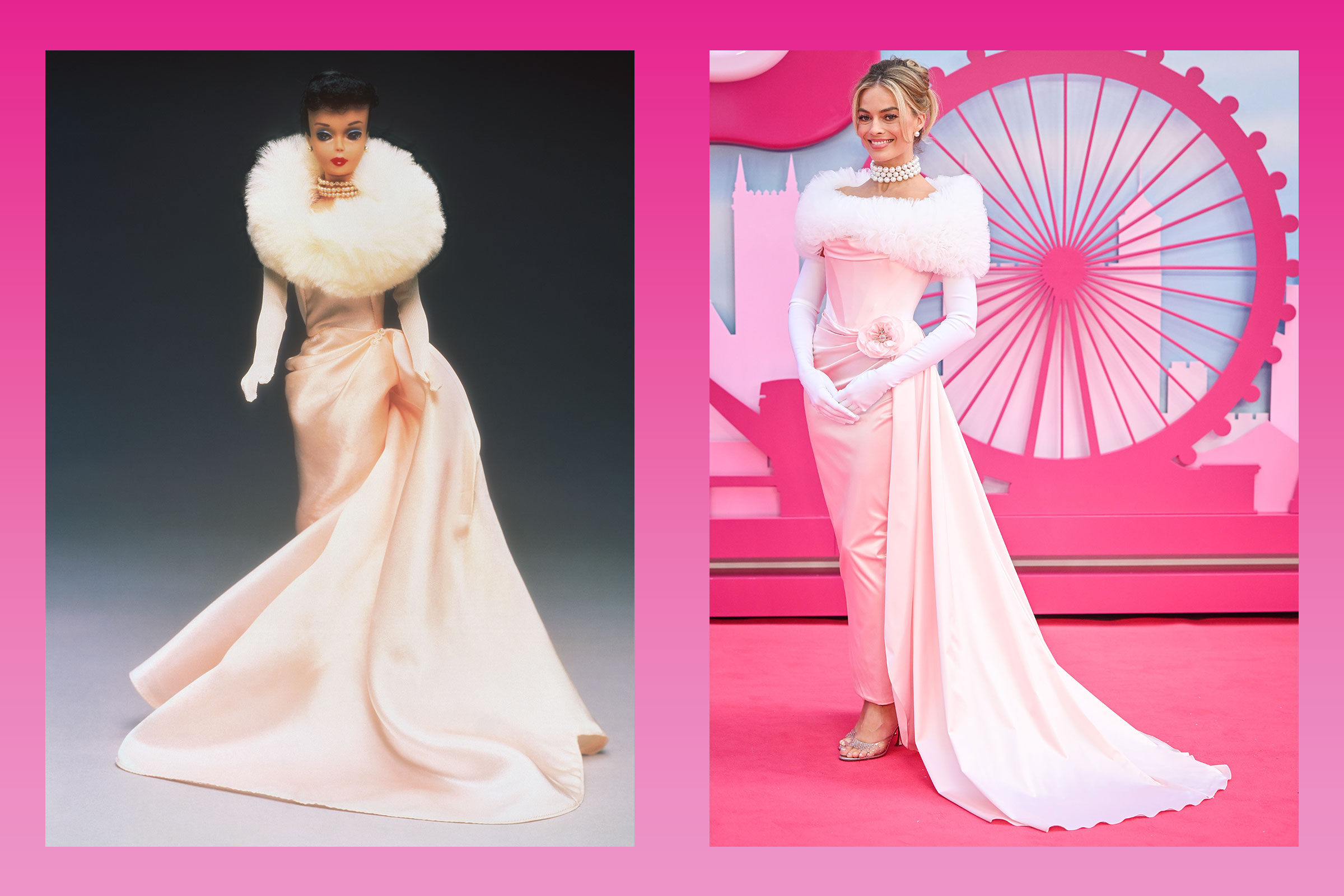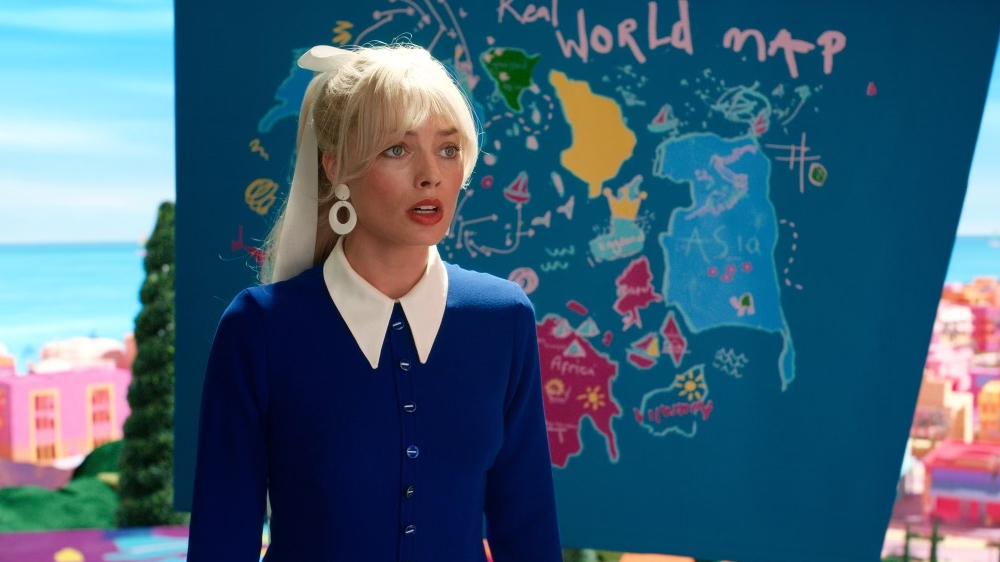You’d be forgiven for thinking only one movie is coming out this year. It’s Barbie’s world, and we’re just living in it. Perhaps we should have anticipated the Barbie craze. After all, more than a billion dolls have been sold worldwide since Barbie’s debut in 1959.
Barbie is 64 years old, and yet this is the first time she’ll star in a live-action movie on the big screen. A Barbie movie has been in the works since at least 2009, but versions with stars like Anne Hathaway and Amy Schumer stalled in part because Mattel was nervous about attaching a face and a personality to the doll. Barbie has no inner life on purpose; children are supposed to project their hopes and dreams onto her blank canvas.
Now, director Greta Gerwig is finally bringing not just one but several Barbies to the big screen—many of whom are featured on a recent cover of this magazine. Here’s everything you need to know about how the Barbie movie came to be and the frenzy around its opening, from the star-studded soundtrack to Margot Robbie’s red carpet looks to how the movie’s rivalry with Oppenheimer came to dominate social media. —Eliana Dockterman
What is Barbie about?
Barbie merchandise and marketing
The Greta Gerwig of it all
The fashion
The soundtrack
The power of Ryan Gosling
Barbenheimer mania
The geopolitical controversy
The movies that inspired Barbie
The creator of Barbie
The Barbenheimer box office
What is Barbie about?
The marketing may be inescapable, but Warner Bros. has done a good job of keeping the plot of Barbie under wraps. We’ve seen the movie, and here’s what we can reveal: The film is set in Barbie Land, a utopia where each Barbie has an equally impressive job, ranging from diplomat to scientist to Supreme Court Justice. As Helen Mirren’s narrator wryly tells us, “all problems of feminism and equal rights have been solved.” The Barbies have sleepovers every night during which they declare how beautiful and confident they feel. The Kens exist as convenient dance partners. But then Margot Robbie’s Barbie begins to think about mortality. Looking for answers, she ventures into the real world with Ryan Gosling’s Ken, who has been feeling like a mere accessory in Barbie’s dream life. The real world is, well, real. Men in suits at Mattel—led by Will Ferrell’s CEO—make disingenuous speeches about female empowerment; tweens dress Barbie down for wreaking havoc on their self-esteem. Both Barbie and Ken go on quests of self-discovery, and that’s when things get really interesting.

The movie doesn’t stick to a single genre: Somehow Barbie is a satire of a toy company’s capitalist ambitions, a searing indictment of the current fraught state of gender relations, a heartwarming if occasionally clichéd tribute to girl power, and a musical spectacle filled with earworms from Nicki Minaj and Dua Lipa. And then some. —Eliana Dockterman
Barbie merchandise and marketing
Along with a relentless press tour that has seen Barbies and Kens—or at least the actors playing them—grace the cover of seemingly every magazine (including ours), this summer has also played host to a blitz of Barbie merchandising. Warner Bros. and Mattel have partnered with everyone from Bloomingdales to Pinkberry to roll out pink products. The fashion and makeup collaborations were perhaps to be expected. But Barbie pasta? A Barbie XBox? Barbie and Ken popping up on the Bumble dating app? The scale of this marketing campaign may be unprecedented.

Still, the real reason that predictions for Barbie’s box office have nearly doubled in the last few weeks may have less to do with the fact that you can’t cross a street in a major city without spotting a Barbie ad and more to do with the fact that that ad is pink. Barbie is unapologetically leaning into the feminine aesthetic and courting a female audience—still a rarity in Hollywood. Big budget movies, including Barbie’s rivals at the box office, Oppenheimer and Mission: Impossible, tend to be marketed toward a male audience.
But, as Gerwig told TIME in her interview for our cover story, the movie was always going to be at its heart a mother-daughter film. Just about every woman has played with Barbie at some point in her life and has an opinion on the doll, whether they love her or hate her. As the Barbie trailer says, “If you love Barbie, this movie is for you. If you hate Barbie, this movie is for you.” —Eliana Dockterman
More from TIME
The Greta Gerwig of it all
Fans of Gerwig were probably surprised when she signed on to Barbie. What was the writer-director of Lady Bird and Little Women doing filming what could easily turn into a Mattel commercial? But Gerwig told TIME that she was a huge fan of dolls as a kid—she was still playing with them in junior high: “Kids were drinking, and I was playing with dolls.” And she stuffed the film full of ideas—about capitalism, the patriarchy, religion, 1950s Hollywood musicals, and Sylvester Stallone’s sartorial choices, to name just a few.

The folks at Mattel have been notoriously protective of Barbie’s image over the years, and the head of Mattel Films, Robbie Brenner, told the toy company executives they would have to “white knuckle” it through the creative process as Gerwig and producer-star Robbie pushed the limits on how much they could poke fun of the iconic and controversial doll. That led to occasional clashes, including a moment when Mattel President Richard Dickson flew to London to argue with Gerwig and Robbie over a particular scene. Dickson told TIME they changed his mind by performing the scene for him. The resulting film is a mashup of something both uniquely Gerwig, filled with all her quirks, and a project of corporate ambition to sell more dolls. —Eliana Dockterman
The fashion
Though the marketing push surrounding Barbie has been groundbreaking, ubiquitous, and very, very pink, the most memorable part of the film’s promotionmay be the red carpet (ahem, pink carpet) looks sported by star Margot Robbie, who’s taken inspiration from iconic looks worn by the doll over the years. While it could have been easy for Robbie to simply rely on the ultra-pink Barbiecore trend for the film’s press tour, she and stylist Andrew Mukamal instead turned to the style archives of the world’s most famous doll.
From the signature black and white swimsuit and peep toe stiletto mules sported by the first Barbie doll in 1959 to the glamorous glittering black cocktail sheath with matching opera gloves worn by the “Solo in the Spotlight” doll that debuted in 1960, Robbie and Mukamal have found a way to not only channel, but also playfully reinterpret Barbie’s most iconic looks through high fashion collaborations with brands like Schiaparelli, Moschino, and Vivienne Westwood.

With her Barbie homages, Robbie isn’t just delivering exquisite looks or compelling marketing for Mattel—she’s also setting a new and incredibly high bar for what the future of the red carpet looks like. Here’s to a new (and far more playful) era of film promotion. —Cady Lang
The soundtrack
There’s been plenty of buzz around Barbie’s star-studded soundtrack. Lizzo, Nicki Minaj, Ice Spice, Charli XCX, and Karol G are just a few of the high-profile artists featured on the album, which is executive produced by the superproducer Mark Ronson.
In an interview, Mark Ronson describes what it was like making the album, finding the right collaborators, and jumping on the opportunity to work with Greta Gerwig and Noah Baumbach. “Those two make some of my favorite films,” he says. “I thought, ‘Even if I don’t get this gig, I know this is going to be my favorite movie next year.’” So he signed on to do the project, and he and Gerwig hit the ground running: “I became the Robin to her Batman,” he says.
And after weeks of teasing, Ronson finally revealed that Billie Eilish—who the producer told TIME was “one of the f-cking greatest living artists around”—had contributed a song called “What Was I Made For?”—Moises Mendez II
The power of Ryan Gosling
The movie’s trailer makes the case that Barbie is everything and her male companion is “just Ken.” But it’s clear from the film’s press tour that Ryan Gosling is far more than just Barbie’s main squeeze. Throughout the film’s promotion, Gosling has been anything but plastic—delivering endless charm to journalists and fans alike by talking about how to channel your “Kenergy,” sporting numerous dapper pastel suits, extolling the virtues of director Greta Gerwig (and even wearing a shirt with her name on it), and praising his wife Eva Mendes and their two daughters. While he might not be the titular star of Barbie, Gosling has proven he’s a major player—and a joy and delight—when it comes to generating buzz around the film. —Cady Lang
Barbenheimer mania
What happens when two of the most anticipated films of 2023 debut in the same week? A fan-made movie crossover event known as Barbenheimer.
Barbie will be released on July 21, and so will Oppenheimer, Christopher Nolan’s film about the development of the atomic bomb. Summer movie-goers are relishing the chance to celebrate a one-day cinematic experience of watching two polar-opposite films back-to-back. According to Elizabeth Frank, AMC’s CCO and executive VP of worldwide programming, over 20,000 tickets have been sold so far at AMC Theaters to see Barbie and Oppenheimer on the same day.
The filmmakers and actors from both films are in on the fun, playfully leaning into the crowded film lineup to encourage more people to the movies. Gerwig and Robbie joined in, buying tickets to Oppenheimer, as well as the new Mission Impossible and Indiana Jones movies. Both Nolan and leading man Cillian Murphy of Oppenheimer have addressed the frenzy, with Nolan telling IGN, “I think for those of us who care about movies, we’ve been really waiting to have a crowded marketplace again, and now it’s here and that’s terrific.” —Mariah Espada
The geopolitical controversy
Barbie has landed in hot water in some parts of the world for a seemingly innocuous scene featuring a map that critics have alleged depicts the “nine-dash line”—a maritime border that, although rejected by an international tribunal at The Hague, has been used by China to assert ownership of practically all of the South China Sea.

Vietnam authorities banned the movie from being released in the country over the map, which Warner Bros. has said was meant simply to be a “whimsical, child-like crayon drawing” and was “not intended to make any type of statement.” The Philippines, another country that disputes China’s territorial claims in the South China Sea, approved Barbie for release—justifying the decision in part by the fact that the line in question has only eight dashes—but requested the map scene be blurred to prevent further misinterpretation.
It’s not clear what exactly eight dashes jutting out the side of a misshapen Asia continent are supposed to represent, but it’s not the first time that this issue has caused controversy in the region, raising questions about the relationship between Hollywood and Beijing—and the extent some studios will go to appease China for access to its massive market.—Chad de Guzman
The movies that inspired Barbie
There are so many references and easter eggs in Barbie it would take multiple viewings to catch every one. The movie isn’t a musical, exactly, but it does have several song-and-dance numbers inspired by the soundstage musicals of the 1930s, 1940s, and 1950s, particularly Gene Kelly films like An American in Paris and Singin’ in the Rain. But Gerwig also drew inspiration from much more contemporary films, and references to movies like The Matrix, Clueless, and even Zack Snyder’s cut of the Justice League find their way into the movie. And Gerwig didn’t stop at studying film. She also extended our interview for the Barbie cover story just to tell me that specific shots in the film were modeled on Michaelangelo’s Creation of Man, which adorns the Sistine Chapel. Like I said, there’s a lot going on in this movie. —Eliana Dockterman
The creator of Barbie
Before there was Barbie, girls mostly played with baby dolls designed to train them to be nurturing mothers. Barbie, dreamt up by Mattel co-founder Ruth Handler, was the first “fashion doll” who had the body and stature of an adult woman. Girls could project their future selves onto the doll rather than care for her. Eventually, they could dress her up to be a doctor, an astronaut, or even president of the United States. Handler named the doll after her daughter Barbara, a tidbit that led Greta Gerwig to ground Barbie in a mother-daughter story.
But Handler was a complicated woman who, as the Barbie film alludes to, was pursued by the IRS. In the movie she’s a god-like figure, even if a flawed one. —Eliana Dockterman
The Barbenheimer box office
Barbie outperformed even the most optimistic prognosticator’s predictions about the movie: The movie earned $337 million worldwide its opening weekend, the biggest debut of 2023 so far and the largest box office victory for a female director in the history of film.
Though it initially seemed like Barbie and Oppenheimer might cannibalize one another at the box office, it turns out that Barbie buoyed the World War II era biopic: According to a poll by The Quorum, 6% of people who saw Oppenheimer did so because Barbie was sold out. Together, they set a post-pandemic record at the box office. Not since Avengers: Endgame premiered in 2019 have so many people flocked to movie theaters. Studios are already scrambling to find lessons about how future films might coax audiences away from streaming services and back to the cinema.—Eliana Dockterman
More Must-Reads From TIME
- The 100 Most Influential People of 2024
- Coco Gauff Is Playing for Herself Now
- Scenes From Pro-Palestinian Encampments Across U.S. Universities
- 6 Compliments That Land Every Time
- If You're Dating Right Now , You're Brave: Column
- The AI That Could Heal a Divided Internet
- Fallout Is a Brilliant Model for the Future of Video Game Adaptations
- Want Weekly Recs on What to Watch, Read, and More? Sign Up for Worth Your Time
Write to Eliana Dockterman at eliana.dockterman@time.com and Cady Lang at cady.lang@timemagazine.com
